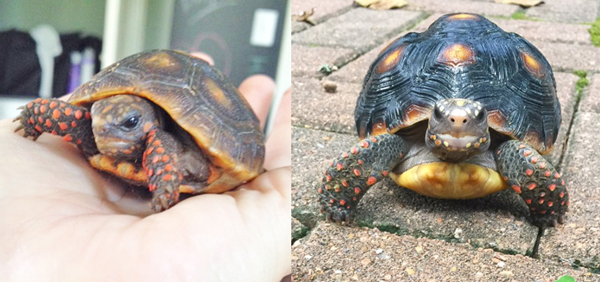Looking for Malti & Bruce’s blog? Visit them HERE.
Meet Malti
Malti is a red-foot tortoise (you can tell by all the red dots on her feet).

Are you sure she’s a girl?
Malti’s breeder and her vet are both pretty sure she is a girl tortoise. We will know for sure if her top shell shape stays more oval-round and her shell underside (plastron) stays flat and even as she grows up. Stay tuned….!
How did you & Malti meet?
“Malti” is an Indian girl’s name meaning “small fragrant jasmine flower.” After many months of sharing life together, I can verify she smells like nothing of the sort. But I’ve always loved the name, so Malti it is.
Malti was an impulse purchase, which is pretty much the worst kind when you are purchasing a living being that will need a lifetime of love and care. What happened was, I had had an argument with my significant other and was supposed to be researching apartments on the internet. Instead, I entered a search for “reptiles.” Up popped the cutest baby turtle face I’d ever seen (which in fact I later learned was a baby tortoise face – there are some important differences I’ll get into elsewhere on this site).
I was hooked. The ad said “baby tortoises in need of rehoming.” I emailed and volunteered my home. Three days later I found myself in possession of a silver dollar-sized bundle of red dots with wild black eyes and the kind of hair-trigger startle reflexes you usually only find in Wild West gunslingers. And so our journey began…and continues.
Can you tell me more about Malti’s species?
Red-foot tortoises (Chelonoidis carbonaria) hail from tropical South America. Their habitats can vary greatly depending on the region of their birth, but by and large they tend to be found in dense forest areas with lots of underbrush and not a lot of direct sunlight. As such, their living quarters in captivity must mimic the warmth and humidity they would get in the wild.
Red-footed tortoises can grow as large as 19″ long and live for 50+ years. Their bodies are strong and solid and as they grow up their front legs become especially well-developed for digging and walking. To me, their back legs look like mini-elephant legs. Totally cute. They have great vision and smell (hearing not so much) and are very smart and curious.
Meet Bruce
Bruce is a 3-toed box turtle (you can tell by looking at his back feet and counting the number of toes).

Are you sure he’s a boy?
We know Bruce is a boy turtle because he has a concave area on his lower shell (plastron), red-orange eyes and additional coloration on his face. Since he is an adult, it was much easier to solve the gender mystery….plus his vet confirmed it.
How did you & Bruce meet?
When Bruce came to us in May 2016, I was working with a fabulous animal communicator to find Malti, who had gone missing. During the week she was gone, Bruce was rescued to me twice. For him, the second time was a charm…and for the next week, he lived in my office underneath my file cabinet (he was having none of the temporary, um, box I set up for him to live in).
In his short-lived free run of the office, he claimed EVERYTHING. The giant stuffed alligator, the black hide box, the twin blue shag rug “turtle runs”….when I asked the animal communicator what his name was, she said she was getting something strong, masculine – something that started with a “B,” like Bruce. She told me, “He doesn’t want a name that is wimpy.” Instantly I saw in my mind the shark from “Finding Nemo” who goes to a support group to try to stop eating fish. So “Bruce” it was….and is.
Can you tell me more about Bruce’s species?
Three toed-box turtles (Terrapene carolina triunguis) are native to Texas where we live, and are approaching endangered status. They get their name from the 3 toes on their back legs (although some have 4 toes, go figure). Their shells have a special olive color and the males have red-orange eyes and distinctive colorations on their faces. They have great vision and smell and are very bright and curious, yet also shy, especially when handled.
Box turtles tap out at around 5 inches long and are very lightweight. They are also the only turtles that can completely hinge themselves inside their shells, which is where they get the rest of their name: “box turtle.” In the wild they have been known to live as long as 100 years. Bruce’s vet says he is “an especially good-looking male 3-toed box turtle.” His proud mommy can’t help but agree.
